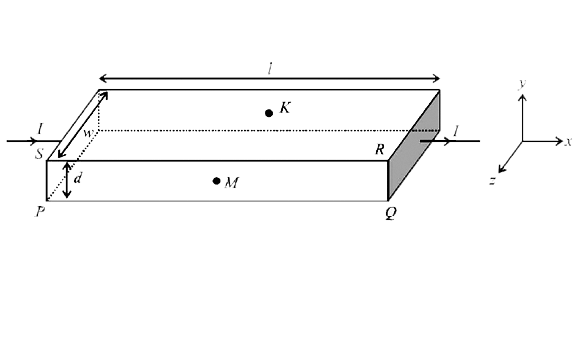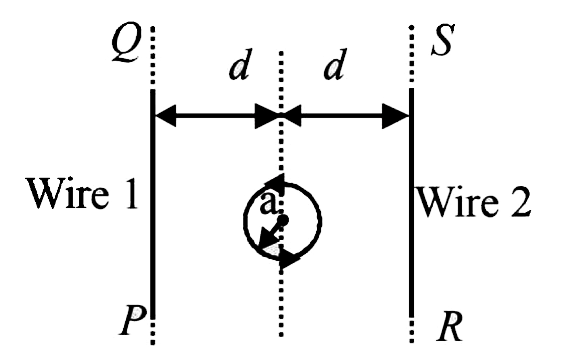Complete Solutions to COMPETITION FILE (D. MULTIPLE CHOICE QUESTIONS) of chapter MOVING CHARGES AND MAGNETISM of Class 12 book with complete answers and questions
| Class 12 | PHYSICS |
| Chapter | MOVING CHARGES AND MAGNETISM |
| MODERN PUBLICATION | COMPETITION FILE (D. MULTIPLE CHOICE QUESTIONS) |
| Number Of Questions | 10 |
| Academic Year | 2023-24 |
The magnetic field B inside a long solenoid, carrying a current of 5.00 A, is `(3.14 xx 10^-2)` T. Find the number of turns per unit length of the solenoid.
View SolutionThere is one infinitely long strip of current with a large width , carrying current K per unit width. There is one long solenoid which carries current I. The solenoid is kept near the sheet with its axis parallel to the width of sheet and it is found that the magnetic field near the centre of the solenoid is zero.
If the solenoid is rotated by a `90^(@)` angle from the previous placement, in such a manner that its axis is parallel to the direction of current, what will be the net magnetic field near the centre of the solenoid?
View SolutionThere is one infinitely long strip of current with a large width , carrying current K per unit width. There is one long solenoid which carries current I. The solenoid is kept near the sheet with its axis parallel to the width of sheet and it is found that the magnetic field near the centre of the solenoid is zero.
If the solenoid is further rotated in such a manner that its length is perpendicular to the sheet and current and one end of the solenoid is near the sheet, what will be the net magnetic field at the centre of this end of solenoid?
View SolutionA uniform magnetic field B is applied in a region that is outwards, perpendicular to the plane of paper, as shown in the figure.

Two charges of the same magnitude 4, of opposite polarity, are projected towards each other with the same speed v. Both the particles are having same masam. Let Vo be the maximum magnitude of so that the particles do not collide. Here we have to neglect the electric force of repulsion between the charges.
What will be the magnitude of `v_(0)` ?
View SolutionA uniform magnetic field B is applied in a region that is outwards, perpendicular to the plane of paper, as shown in the figure.

Two charges of the same magnitude 4, of opposite polarity, are projected towards each other with the same speed v. Both the particles are having same masam. Let Vo be the maximum magnitude of so that the particles do not collide. Here we have to neglect the electric force of repulsion between the charges.
If the particles are projected with `v_(0)//2`, then what can be the minimum separation between them?
View SolutionA uniform magnetic field B is applied in a region that is outwards, perpendicular to the plane of paper, as shown in the figure.

Two charges of the same magnitude 4, of opposite polarity, are projected towards each other with the same speed v. Both the particles are having same masam. Let Vo be the maximum magnitude of so that the particles do not collide. Here we have to neglect the electric force of repulsion between the charges.
If the particles are projected with `2v_(0)`, then how much time will the particles take to collide?
View SolutionA uniform magnetic field B is applied in a region that is outwards, perpendicular to the plane of paper, as shown in the figure.

Two charges of the same magnitude 4, of opposite polarity, are projected towards each other with the same speed v. Both the particles are having same masam. Let Vo be the maximum magnitude of so that the particles do not collide. Here we have to neglect the electric force of repulsion between the charges.
If the particles are projected with `2v_(0)` and collision between them is perfectly inelastic, then what path is followed by the particles after collision? (Neglect other forces)
View SolutionIn a thin rectangular metallic strip a constant current I flows along the positive x-direction, as shown in the figure. The length, width and thickness of the strip arel, `omega" and " d,` respectively.
A uniform magnetic field B is applied on the strip along the positive y direction. Due to this, the charge carriers experience a met deflection along the 2-direction. This results in accumulation of charge carriers on the surface PQRS and appearance of equal and opposite charge on the face opposite to PQRS. A potential difference along the 2 direction is thus developed, Charge accumulation continues until the magnetic force is balanced by the electric force. The current is assumed to be uniformly distributed on the cross section of the strip and carried by electrons.

Consider two different metallic strips (1 and 2) of the same material. Their lengths are the same, widths are `omega_(1)" and " omega_(2)` and thickness are `d_(i) " and " d_(2)`, respectively. Two points K and M are symmetrically located on the opposite faces parallel to the x-y plane (see figure). `V_(1)" and "V_(2)` are the potential differential differences between K and M in strips 1 and 2, respectively. Then, for a given current I flowing through them in a given magnetic field strength B, the correct statement(s) is (are)
View SolutionIn a thin rectangular metallic strip a constant current `I` flows along the positive `x`-direction , as shown in the figure. The length , width and thickness of the strip are `l, w and d`, respectively.
A uniform magnetic field `vec(B)` is applied on the strip along the positive `y- direction` . Due to this, the charge carriers experience a net deflection along the `z- direction` . This results in accumulation of charge carriers on the surface `PQRS` ansd apperance of equal and opposite charges on the face opposite to `PQRS`. A potential difference along the `z-direction` is thus developed. Charge accumulation contiues untill the magnetic force is balanced by the electric force. The current is assumed to be uniformly distributed on the cross- section of the strip and carried by electrons.
Consider two different metallic strips `(1 and 2)` of same dimensions `n_(1) and n_(2)`, repectrively . Strip 1 is placed in magnetic field `B_(1)` and strip 2 is placed in magnetic field `B_(2)` , both along positive ` y- directions`. Then ` V_(1) and V_(2)` are the potential differences developed between `K and M` in strips 1 and 2 , respectively . Assuming that the current `I` is the same for both the strips, the correct option(s) is (are)

View SolutionThe figure shows a circular loop of radius `a` with two long parallel wires `(numbered 1 and 2)` all in the plane of the paper . The distance of each wire from the centre of the loop is `d`. The loop and the wire are carrying the same current `I`. The current in the loop is in the counterclockwise direction if seen from above.
(q) The magnetic fields(B) at `P` due to the currents in the wires are in opposite directions.
(r) There is no magnetic field at `P`.
(s) The wires repel each other.

(4) When `d~~a` but wires are not touching the loop , it is found that the net magnetic field on the axis of the loop . In that case
View Solution
COMPETITION FILE (D. MULTIPLE CHOICE QUESTIONS) questions and complete solutions for chapter MOVING CHARGES AND MAGNETISM of MODERN PUBLISHERS PHYSICS (HINGLISH) of Class 12
All Exercises from MODERN PUBLICATION Class 12 PHYSICS MOVING CHARGES AND MAGNETISM
- CHAPTER PRACTICE TEST
- COMPETITION FILE (A. MULTIPLE CHOICE QUESTIONS)
- COMPETITION FILE (ASSERTION TYPE QUESTIONS)
- COMPETITION FILE (B. MULTIPLE CHOICE QUESTIONS)
- COMPETITION FILE (C. MULTIPLE CHOICE QUESTIONS)
- COMPETITION FILE (D. MULTIPLE CHOICE QUESTIONS)
- COMPETITION FILE (INTEGER TYPE QUESTIONS)
- COMPETITION FILE (MATRIX MATCH TYPE QUESTIONS)
- Conceptual Questions
- Higher Order Thinking Skills & Advanced Level
- NCERT (Exemplar Problems ) (Short Answer Type Questions )
- NCERT (Exemplar Problems ) (Very Short Answer Type Questions )
- NCERT (Exemplar Problems ) Objective Questions (MCQ Type - I)
- NCERT (Exemplar Problems ) Objective Questions (MCQ Type - II)
- NCERT FILE (NCERT Additional Exercises)
- NCERT FILE (NCERT Textbook Exercises)
- PRACTICE PROBLEMS
- Revision Exercises (Additional Questions )
- Revision Exercises (Fill in the Blanks )
- Revision Exercises (Long Answer Questions )
- Revision Exercises (Numerical Problems )
- Revision Exercises (Short Answer Questions )
- Revision Exercises (Very Short Answer Questions )
- SOLVED EXAMPLES
- Tough & Tricky (PROBLEMS )